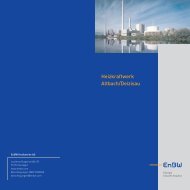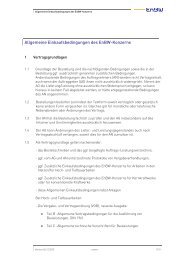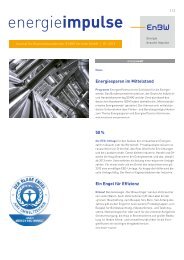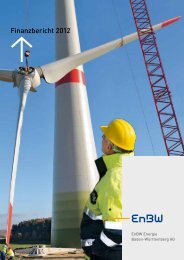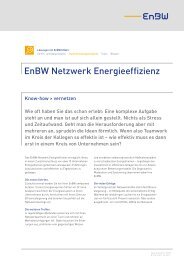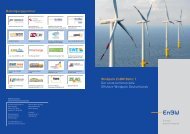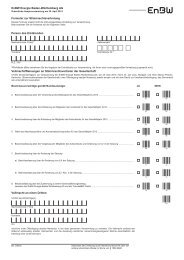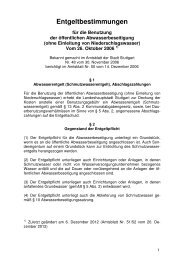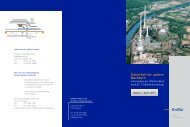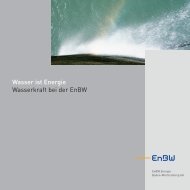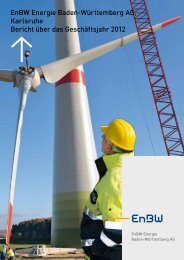Environmental Report 2000 - EnBW
Environmental Report 2000 - EnBW
Environmental Report 2000 - EnBW
You also want an ePaper? Increase the reach of your titles
YUMPU automatically turns print PDFs into web optimized ePapers that Google loves.
State of the Environment <strong>Report</strong><br />
Avoiding waste and recycling secondary raw materials<br />
In accordance with our belief in a closed-loop economy, we subscribe to the principle of<br />
minimising the production of waste and recycling whatever waste is produced. This is a<br />
principle we have fully integrated into our business operations.<br />
Our coal-fired power plants which are<br />
responsible for producing the main<br />
part of secondary raw materials and<br />
waste are a case in point: we have<br />
now achieved a performance where<br />
94% of all waste material can be<br />
recycled. The 217,000 tonnes of kfly<br />
ash and kgypsum collected during<br />
<strong>2000</strong> from the kdust separator in<br />
the electric filter or from the kflue<br />
gas desulphurisation unit after due<br />
quality control and certification have<br />
been sold to the construction materials<br />
industry as secondary raw materials.<br />
The gypsum we obtain from the<br />
flue gas purification process has a<br />
particularly sparing effect on the consumption<br />
of primary raw material and<br />
has been given the seal of the “blue<br />
eco-angel” by the Federal Office for<br />
the Environment.<br />
We were able to recycle 57% of the<br />
waste from the <strong>EnBW</strong> energy division;<br />
however, the refurbishment of the<br />
cooling towers at Heilbronn and<br />
Philippsburg produced a relatively<br />
high, if non-recurrent, quota of nonrecyclable<br />
waste.<br />
28<br />
Secondary Raw Materials in t<br />
Ash Granulate<br />
155,334 t<br />
Boiler Sand<br />
14,479 t<br />
Sludge as fertiliser for the farm<br />
Gypsum<br />
61,495 t<br />
Residual Lime<br />
3,554 t<br />
We have also delivered 3,600 tonnes<br />
of certificated sludge to the agricultural<br />
sector for use as fertiliser on the land<br />
and for soil improvement. Gained<br />
from the auxiliary water treatment<br />
unit at the cooling tower of the Heilbronn<br />
plant.<br />
Overview of Main Types of Waste in the Energy Division in %<br />
Rakings<br />
3,400,6 t<br />
Asbestos-based Construction Materials,<br />
Mineral Fibres 5,133,9 t<br />
17.66%<br />
26.66%<br />
16.07%<br />
14.34%<br />
In all our companies we take stock of<br />
the amount of waste produced once<br />
a year and every five years we draw<br />
up a waste management strategy for<br />
minimising and recycling waste. In<br />
this context our treatment and disposal<br />
subsidiary U-plus has a range of<br />
excellent services and cutting-edge<br />
techniques.<br />
To promote graded recycling, we dispose<br />
of the different kinds of waste<br />
in separate and clearly labelled containers,<br />
thus permitting the disposal<br />
of smaller amounts of waste.<br />
This is a principle which doesn’t just<br />
apply to our power plant sites but to<br />
all of our other installations, sites,<br />
companies and administrative offices.<br />
15.31%<br />
9.96%<br />
Metallic Scrap<br />
3,093,8 t<br />
Other Types<br />
2,762,8 t<br />
Construction/Demolition Debris<br />
(excluding asbestos) 2,948,3 t<br />
Sludge from Oil and Water Precipitators<br />
1,917,2 t<br />
Success in reducing emissions of hazardous air pollutants<br />
Industrial sites, power plants, factories and vehicles produce emissions of harmful air<br />
pollutants like sulphur dioxide, nitrogen oxide, carbon monoxide, dust and the greenhouse<br />
gas CO2. It is vital, taking into consideration both the current state of technological development<br />
and the economic and ecological opportunities, to keep these emissions to a<br />
bare minimum.<br />
A few years ago, we invested a great<br />
deal of money in retrofitting our old<br />
coal-fired power plants with flue gas<br />
desulphurisation and denox facilities<br />
whilst all new units were equipped in<br />
line with the latest developments in<br />
environmental technology. This investment<br />
has had a markedly positive<br />
effect in reducing emission levels of<br />
hazardous gas.<br />
We have installed calibrated measuring<br />
devices in our power plant chimney<br />
stacks for continuous emission measurement<br />
to ensure strict observance<br />
of official critical limits. Protocols are<br />
delivered to the authorities. The protocols<br />
of our coal-fired plants at Heilbronn<br />
and Karlsruhe in particular are<br />
compelling evidence of what can be<br />
achieved to cut back emission levels<br />
of sulphur dioxide and nitrogen oxide.<br />
Regression of Specific SO 2 Emissions in Heilbronn and Karlsruhe<br />
in g/kWh<br />
7<br />
6<br />
5<br />
4<br />
3<br />
2<br />
1<br />
0<br />
1984 1985 1986 1987 1988 1989 1990 1991 1992 1993 1994 1995 1996 1997 1998 1999 <strong>2000</strong><br />
Regression of Specific NO 2 Emissions in Heilbronn and Karlsruhe<br />
in g/kWh<br />
7<br />
6<br />
5<br />
4<br />
3<br />
2<br />
1<br />
0<br />
1984 1985 1986 1987 1988 1989 1990 1991 1992 1993 1994 1995 1996 1997 1998 1999 <strong>2000</strong><br />
29



